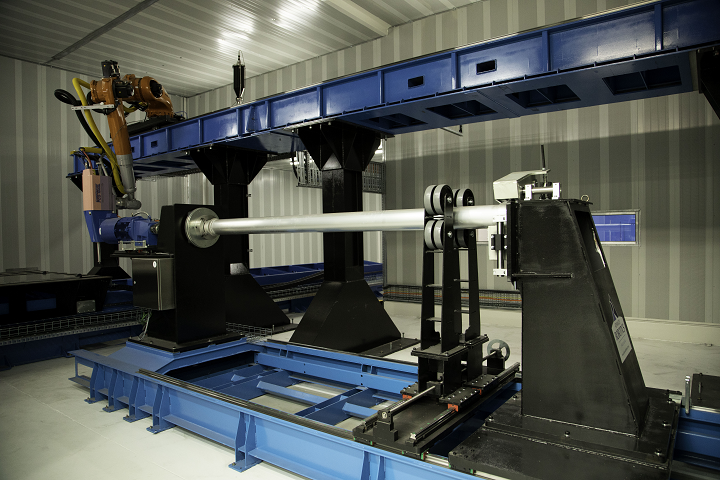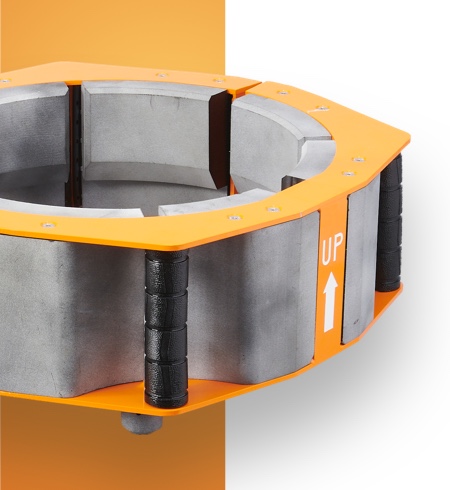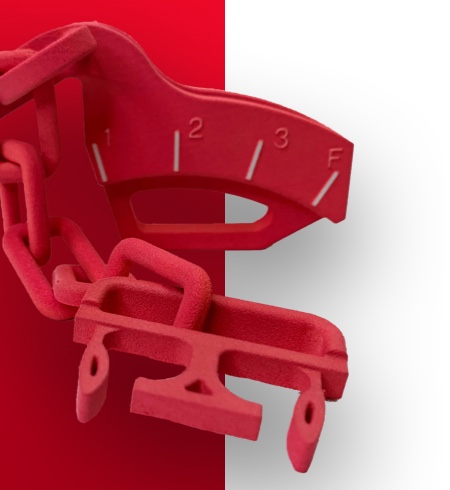New 3D printing jobs at ScheMatter, appointments at AMT, Titomic, Dyndrite, BEAMIT and more
APWORKS’ high-strength Scalmalloy approved for Formula 1
ArianeGroup successfully tests fully-3D printed combustion chamber for ESA rocket engine
Eight industrial partners set to work on modular hybrid manufacturing system
Titomic Signs Agreement with Airbus to Make 3D Printed Metal Demonstrator Parts
Global aerospace leader Airbus develops, creates, and delivers innovative solutions in the commercial aircraft, defense, helicopter, space, and security sectors, and has long been a champion of using additive manufacturing to do so. Airbus installed its first 3D printer back in 2012, and used its first metal 3D printed part – a titanium bracket – in one of its commercial jetliners just two years later. Now, over 1,000 3D printed parts are used in its A350 XWB aircraft.
 In order to deliver 3D printed aerospace solutions, the European aircraft manufacturing giant has partnered up with many big names in the industry, from Local Motors and Materialise to Premium AEROTEC and GE Aviation, and just today announced a new collaboration. Australian large-scale, industrial AM company Titomic has just reached a major agreement with Airbus, which will use the Melbourne company’s patented Titomic Kinetic Fusion (TKF) technology to demonstrate high-performance metal parts.
In order to deliver 3D printed aerospace solutions, the European aircraft manufacturing giant has partnered up with many big names in the industry, from Local Motors and Materialise to Premium AEROTEC and GE Aviation, and just today announced a new collaboration. Australian large-scale, industrial AM company Titomic has just reached a major agreement with Airbus, which will use the Melbourne company’s patented Titomic Kinetic Fusion (TKF) technology to demonstrate high-performance metal parts.
“We are pleased to partner with Airbus for this initial aerospace part made with Titomic Kinetic Fusion® (TKF), the world’s largest and fastest industrial-scale metal additive manufacturing process,” stated Titomic CEO Jeff Lang in a press release. “The TKF process ideally suited to produce near-net shape metal parts for the aerospace industry using our patented process of fusing dissimilar metals that cannot be produced with either traditional fabrication methods or metal-based 3D printers.”
TKF is the result of a Commonwealth Scientific and Industrial Research Organisation (CSIRO) study, when Australia’s government was looking to capitalize on its titanium resources. Titomic’s proprietary TKF technology platform uses a process similar to cold spray, and has no limits in terms of build shape and size. A 6-axis robot arm sprays titanium powder particles, at supersonic speeds, onto a scaffold in order to build up complex parts layer by layer.
 Thanks to its unique AM technology, Titomic can provide its customers with production run capabilities, which helps rapidly create excellent products, with decreased material waste, that have lower production inputs.
Thanks to its unique AM technology, Titomic can provide its customers with production run capabilities, which helps rapidly create excellent products, with decreased material waste, that have lower production inputs.
“3D printing, of which TFK is the leading technology, has the potential to be a game changer post the global COVID-19 pandemic supply chain disruption as aircraft manufacturers look to reduce production costs, increase performance, improve supply chain flexibility and reduce inventory costs, and TKF, co-developed with the CSIRO, can be an integral part of this change,” said Lang.
“Regulations force aerospace manufacturers to provide spare parts for long periods after the sale of an aircraft, so it’s not rocket science to assume they will be early adopters of 3D printing solutions for spare-part management.”

The Titomic Kinetic Fusion process involves a 6-axis robot arm spraying titanium powder particles onto a scaffold at supersonic speeds.
TKF technology could be crucially important for aircraft manufacturers, like Airbus, as the field of aviation is one of the largest customers of titanium alloy products. That’s why Titomic has invested in further developing AM so it can meet the material, process, and design qualification system that’s required by the European Aviation Safety Agency (EASA) and the US Federal Aviation Administration (FAA). The company will work to develop TKF 3D printing material properties and parts process parameters for Airbus.
This agreement, the future delivery of the 3D printed demonstrator parts to Airbus, and a technology review process of said parts, all validate the certification process that Titomic’s government-funded IMCRC research project, with partners RMIT and CSIRO, is currently undergoing.
Discuss this story and other 3D printing topics at 3DPrintBoard.com or share your thoughts in the Facebook comments below.
The post Titomic Signs Agreement with Airbus to Make 3D Printed Metal Demonstrator Parts appeared first on 3DPrint.com | The Voice of 3D Printing / Additive Manufacturing.
Titomic receives Airbus purchase order for TKF parts, partners with Triton for US DoD R&D projects
Airbus Subsidiary Uses Full-Color Multi Jet Fusion for Maintenance Tooling
Among the most exciting aspects of HP’s Multi Jet Fusion (MJF) technology when initially unveiled was the ability to 3D print functional objects in a full range of color. Though it took a couple of years for it to happen, that capability finally hit the market in 2018 with the release of the HP Jet Fusion 300/500 Color 3D Printer range. Now we are beginning to see the applications that a broad spectrum of hues has in practice. Airbus services company Satair used the technology to 3D print a series of tools for its maintenance operations.

Used to gag the main landing gears on the A380, the GAGS tool pads were redesigned to improve the strength-to-weight ratio, resulting in 60 percent mass reduction. Image courtesy of HP.
Satair turned to service bureau Fast Radius with the ultimate goal of to speed up aircraft repair with the use of 3D printed tools. As a member of HP’s Digital Manufacturing Network, Fast Radius leveraged MJF to print tools for the company. In particular, the color printing capabilities of the Jet Fusion 580 Color system were utilized to 3D print bright red and orange tools in order to improve job safety and ensure that tools were not misplaced after use. The tools were also optimized to reduce total part count, enhance robustness and integrate new functions.
One particularly unique feature about the company is the fact it has a production hub on-site at the UPS Worldport facility in Louisville, Kentucky, allowing it to potentially ship parts at greater speeds than other service providers.

This pintle bearing alignment tool is used to bear in the rear spar prior to installing it during the installation of the main landing gear installation. Assembly was reduced from four parts to two. Image courtesy of HP.
Three new tools were redesigned and printed by HP and Fast Radius for Satair: GAGS tool pads, pintle bearing alignment tools, and flap zero locking tools. MJF was chosen in part for the ability to 3D print durable parts with the mechanical properties necessary for harsh aircraft repair environments. Specifically, HP 3D High Reusability PA 12 was chosen due to its chemical resistance to oils, grease, aliphatic hydrocarbons and alkalies.
3D printing the parts also sped up design time, as multiple iterations could be produced at once within a single build. The use of color also allowed for the communication of information in unique ways, such as 3D printing part numbers, serial numbers and scannable QR codes directly onto the tool.
Whereas Satair previously waited weeks for new tools to be manufactured, this project saw Fast Radius print, inspect, package and ship two tools in less than 48 hours. This was enabled in part by Fast Radius’s logistics partnership with UPS, with which it sent the items from Chicago to Hamburg, Germany.

This flap zero locking tool is used to lock flaps in the A320 cockpit. The assembly was reduced from six parts to two and resulted in a lead time reduction of 50 percent. Image courtesy of HP.
The use of 3D printing by Satair is just another notch in Airbus’s belt, as the aerospace giant deploys AM all across its business to the point that it is probably not necessary to recount all of the ways it is being used, but we can highlight the myriad parts printed for the A350 XWB, as well as the work of Premium AEROTEC and APWorks.
As for Fast Radius, this is another interesting customer from the service bureau, which is fond of emerging AM technologies. For instance, the company also used Carbon’s Digital Light Synthesis to print parts for Steelcase’s office chair. Outside of 3D printing, Fast Radius offers a number of other manufacturing services, including CNC machining and injection molding. With the Fast Radius Virtual Warehouse, the company is hoping to implement the concept of digital inventory, in which digital files replace physical stock, with goods manufactured on-demand.
As with 3D printing itself, it will take some time for designers and engineers to fully grasp the potential of producing parts in full color. The ability to use bright pigments for safety purposes and to embed QR codes is just the beginning. HP previously demonstrated the use of colors to exhibit the level of wear on a part, so that, as it is worn down, it shows new colors that can be more easily quantified. Augmented reality applications could also be developed based on embedded symbols in a part. In the near future, we may see even more interesting uses of full color printing of end parts.
The post Airbus Subsidiary Uses Full-Color Multi Jet Fusion for Maintenance Tooling appeared first on 3DPrint.com | The Voice of 3D Printing / Additive Manufacturing.
Sigma Labs signs new contracts with Northwestern University, Materialise
GKN Aerospace to Open Latest Additive Industries Process and Application Centre Close to Bristol, UK
GKN Aerospace is just one aspect of the powerhouse of manufacturing activity emanating from GKN—a company rich in history—with origins founded as far back as the 1700s. Overall, GKN presents a huge emphasis on 3D printing and additive manufacturing processes that only continues to grow within all of their main divisions featuring aerospace, automotive, powder metallurgy, and wheels and structures. With main headquarters in the UK, GKN Aerospace continues the overall forward momentum as CTO Russ Dunn opens the latest Additive Industries Process and Application Centre close to Bristol.
![]() So far, other Additive Industries centres have been opened in Eindhoven, Los Angeles, and Singapore. Each facility offers its ‘own specialism’ related to AM processes. The UK & Ireland Process and Application Centre is situated at Filton Aerospace Park, famously known as the site of the Concorde’s development and production in the 60s and 70s. Other important aerospace activities are currently taking place there, as well as engineering and manufacturing, with industry leaders like Airbus, Rolls-Royce, and GKN working nearby.
So far, other Additive Industries centres have been opened in Eindhoven, Los Angeles, and Singapore. Each facility offers its ‘own specialism’ related to AM processes. The UK & Ireland Process and Application Centre is situated at Filton Aerospace Park, famously known as the site of the Concorde’s development and production in the 60s and 70s. Other important aerospace activities are currently taking place there, as well as engineering and manufacturing, with industry leaders like Airbus, Rolls-Royce, and GKN working nearby.
 The site, now completely renovated and ‘in line with all the highest standards,’ has been used for numerous aerospace projects in the past, as well as lightning strike tests. The Additive Industries facility at this site will allow for a focus on both the production of new materials as well as continued process development.
The site, now completely renovated and ‘in line with all the highest standards,’ has been used for numerous aerospace projects in the past, as well as lightning strike tests. The Additive Industries facility at this site will allow for a focus on both the production of new materials as well as continued process development.
On March 12th, Russ Dunn, CTO of GKN Aerospace, Dr Mark Beard, Additive Industries’ Global Director Process & Application Development and General Manager of the Centre, and Daan Kersten, CEO of Additive Industries, will oversee the official opening ceremony of the facility.
The opening ceremony and event will run from 11:00 am to 5:00 pm. There will be a full schedule, featuring presentations and announcements. During the afternoon, those attending can expect the following:
- Presentation about GKN Global Technology Center (also in Filton) – by Paul Perera, VP Technology at GKN Aerospace.
- Discussion on the additive manufacturing vision for Airbus, and perspective on the growing AM ‘ecosystem’ in Filton – by Dave Best, Head of Business and Strategy for Airbus.
- Presentation on APWorks and their choices for advancing in industrialization, working with the Additive Industries Competence Centre in Filton; accompanied by a case study that includes GKN and ANSYS – by Jon Meyer, CPO for APWorks.
Both GKN and Additive Industries continue to be a powerful—and advancing—presence within the AM field, around the world. GKN has collaborated with other companies like GE Additive and Porsche, and recently they purchased Forecast3D. Additive Industries has also been in the 3D printing news headlines as they partnered with APWorks, Volkswagen, the Switzerland-based Sauber F1 Team, and more.
What do you think of this news? Let us know your thoughts! Join the discussion of this and other 3D printing topics at 3DPrintBoard.com.
[Source / Images: Additive Industries]
The post GKN Aerospace to Open Latest Additive Industries Process and Application Centre Close to Bristol, UK appeared first on 3DPrint.com | The Voice of 3D Printing / Additive Manufacturing.


